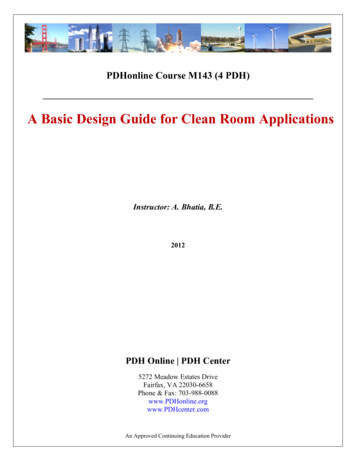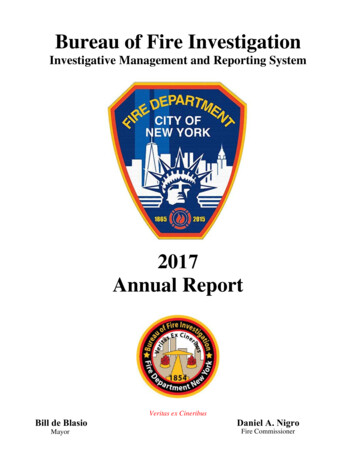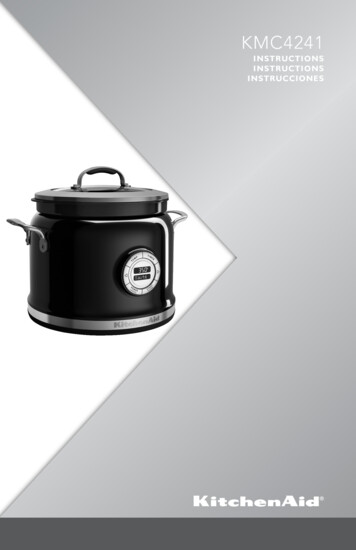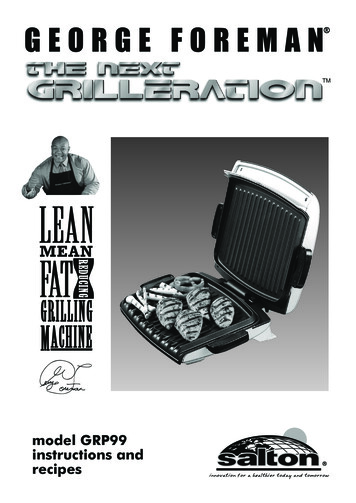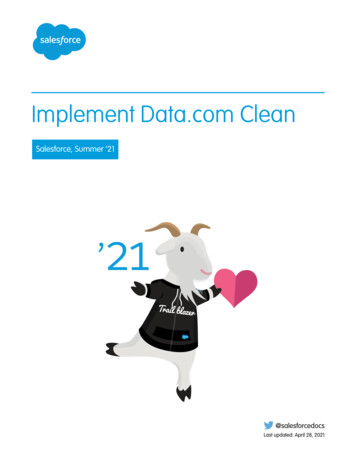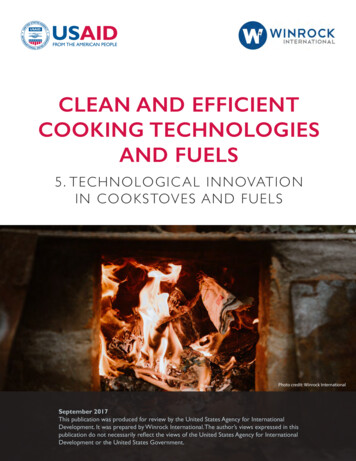
Transcription
CLEAN AND EFFICIENTCOOKING TECHNOLOGIESAND FUELS5 . T E C H N O L OG IC A L INNOVATIONI N C O OK S TOV E S A ND FUE LSPhoto credit: Winrock InternationalSeptember 2017This publication was produced for review by the United States Agency for InternationalDevelopment. It was prepared by Winrock International. The author’s views expressed in thispublication do not necessarily reflect the views of the United States Agency for InternationalDevelopment or the United States Government.
CLEAN AND EFFICIENT COOKING TECHNOLOGIES AND FUELS5. TECHNOLOGIC AL INNOVATIONIN COOKSTOVES AND FUELSUnderstanding of stove design principles has changed significantly from the early days of stove projects in the 1970s and1980s to today, as have stove and fuel production strategies and facilities. Included in this section are examples of themain technologies and fuels currently available for household, institutional and commercial use, recent advancements inresearch and design, as well as examples of different production strategies for stoves and fuels.WHY IT MATTERSLow quality or poor performing technologies or fuels not only reduce or reverseexpected project impacts, but can also spoil the market for future higher qualitytechnologies. Choosing the right stove or fuel is critical, as it must meet theprimary cooking needs of the target consumer to be effective over time.1. Determine which cooking technologies and fuels already exist on themarket for your target consumers. Also research which technologies aremade locally and which are impor ted, and assess the pros and cons ofeach.BEST PRACTICES2. Research the accessibility of different fuels where you’re working. Ifcharcoal is ubiquitous, your alternative fuel must compete not only interms of price but also in terms of accessibility. If there’s no infrastructurein place for easy (and safe) refills, liquid and gas fuels won’t be adoptedas primary cooking fuels and any intervention will prove unsustainable.If consumers currently collect fuel for free, project implementers mustcarefully research ways to introduce fuels that convince end users toinvest their limited resources.3. Stoves and fuels cannot be used interchangeably. Stoves are often –almost always – designed with a specific fuel in mind for optimumperformance. Introducing a new fuel means finding the right technologyto use it in! Don’t assume the performance will be the same with a newfuel.4. Keep the consumer at the forefront of the decision making process whenmaking fuel/technology decisions. A consumer-centric approach will helpyou navigate the tradeoffs associated with every technology or fuel, aswell as different manufacturing options.TECHNOLOGICAL INNOVATION IN COOKSTOVES AND FUELSUSAID.GOV/ENERGY/COOKSTOVES
CLEAN AND EFFICIENT COOKING TECHNOLOGIES AND FUELS“ W E AC T U A L LY H AV E S E T A N I S O R E C O R D F O R T H E H I G H E S TP E R C E N TAG E O F D E V E L O P I N G C O U N T R I E S I N VO LV E D I N S TA N DA R D SD E V E L O P M E N T. W I T H 2 5 PA R T I C I PAT I N G C O U N T R I E S , 2 0 O F T H E M A R ED E V E L O P I N G C O U N T R I E S .”-ZACHARIA LUKORITO CHEPKANIA, ISO TC 285 CO-SECRETARIAT,KENYA BUREAU OF STANDARDSRESEARCH AND TECHNOLOGICAL ADVANCEMENT IN DESIGNRecent efforts in technological design have led to advancements in biomass cookstoves that get much closer to WHOhealth recommendations. Efforts to scale up access to clean burning (gas, liquid, and solar) fuels are also underway, as areinnovative approaches to production and distribution of cleaner-burning biomass pellets.AVAILABLE TECHNOLOGIES AND FUELSThe Global Alliance for Clean Cookstoves (Alliance) has been working to catalog existing cooking technologies and fuelsthat are available worldwide (traditional and improved), tracking key features of the technologies as well as testing results.Currently there are over 300 stoves in its Clean Cooking Catalog, which is searchable by household vs. institutional, fueltype, materials (e.g., metal, ceramic, clay), geography, and price (when pricing information is available). The Catalog allowsconsumers and implementers to compare technology options and make informed choices. It helps researchers and testingcenters by providing initial data to inform future testing and research.There are two main types of stoves available on the market: 1) household stoves, which are used for normal daily cooking– typically 2-3 meals per day, and 2) institutional stoves for cooking in larger group settings or for commercial cooking/restaurants. Household cookstoves, which are lower cost and more widely available, account for the vast majority ofcommercial sales. It is quite common for households to use more than one stove for different cooking needs. Improvedinstitutional stoves, although not as commercially prevalent, can achieve very significant gains, especially in terms of fuelefficiency. In certain settings (e.g., schools, hospitals, refugee/IDP camps, commercial food vendors, etc.) the potential forlarge fuel savings can equate to large monetary savings if fuel is purchased. Where fuel is gathered (e.g., by school childrenor families), institutional stoves can save significant time, and – particularly in IDP/refugee settings – reduce the numberof potentially hazardous trips women must take outside the camp boundaries. Fuel switching from biomass to clean fuelssuch as LPG may not deliver the same monetary savings, but has the potential to deliver other health or time-relatedbenefits.Primary cooking fuels vary by geography, but it’s typical to find any combination of the following: Biomass Fuels: wood, dung, and agricultural waste. Note: Biomass fuels can also be processed into charcoal,briquettes (carbonized or uncarbonized) or pellets Liquid/gas fuels: LPG, ethanol, kerosene, biogas Coal (used for cooking and heating, primarily in China, India and South Africa) Solar/retained heat cookers L INNOVATION IN COOKSTOVES AND FUELS
Photo credit: Winrock InternationalCLEAN AND EFFICIENT COOKING TECHNOLOGIES AND FUELSTECHNOLOGICAL INNOVATION IN COOKSTOVES AND FUELSUSAID.GOV/ENERGY/COOKSTOVES
CLEAN AND EFFICIENT COOKING TECHNOLOGIES AND FUELSDifferent fuels have inherently different amounts of energy to release, and combust differently. For that reason, stovesare almost always designed with a specific fuel in mind. Incomplete combustion results in hazardous emissions that arereleased into the kitchen or environment, leading to health impacts described in more detail in the Health section. Fuelusage and combustion efficiency of biomass fuels are also impacted by how dry the fuel is (i.e., behavioral considerationsfor implementers), as well as how the fuel is prepared.Nearly half the world currently cooks with biomass fuels. Even those households with access to LPG or electricity oftencook some meals or foods on traditional stoves with biomass fuels. Liquid and gas fuels, when used in appropriate stoves,can be significantly faster and cleaner burning than biomass, although kerosene is not typically considered a clean fuel (itcan produce high amounts of health-damaging particulates). However, access to LPG, ethanol and biogas requires thedevelopment of new distribution infrastructure and is still limited, especially in rural areas. Solar is the cleanest fuel forcooking, and free to use, but can only be used during the day when the weather is appropriate. Several groups are makingadvances in solar cooking technologies, but solar cookers tend to be more expensive than other options and requiresignificant behavior change from end users. Solar is often promoted in conjunction with a second type of improved stoveand a retained heat cooker, which together form an integrated cooking package.Selecting the appropriate stove and fuel for a cooking intervention requires a thorough examination of technicaloptions, social and market considerations, priorities, budget and implementation timeframe. The Alliance’s Fuel Analysis,Comparison & Integration Tool (FACIT) and companion report can help implementers weigh various options. The onlineFACIT interface allows for the comparison of different environmental impacts of the production, processing, distributionand use of various cooking fuel options while also incorporating social and economic considerations. The results can beused to compare the trade-offs of different cooking fuels, identifying step in fuel production that have the largest impactsand thus presenting opportunities for improvement.RESEARCH AND DEVELOPMENTRecent years have brought advancements in research and development (R&D) around cleaner, more efficient cookstovesand fuels. The US Government (USG) has led several efforts in R&D for stove design and testing, primarily through theUS Environmental Protection Agency (EPA) Office of Research and Development (ORD) and the US Department ofEnergy, Bioenergy Technologies Office. The US EPA has one of the leading cookstove testing labs at its Research TrianglePark facility. A video about its work is available on the Voice of America website. ORD expertise in cookstoves researchincludes stove performance, emissions, toxicology, health, climate and exposure testing. In 2014 the US EPA STAR grantsprogram awarded 9 million in grants to better quantify health and climate benefits of cookstove changes in the contextof greenhouse gasses (GHGs).In 2014, as part of the USG support for the Alliance, the US DOE awarded 10 million in grants for research aimed ataddressing technical barriers to the development of low emission, high efficiency cookstoves through activities in at leastone of the following four areas: developing low cost, durable stoves that achieve stringent efficiency and emissions goals;understanding the engineering science for advanced stoves; identifying stove designs to meet local cooking needs, and;identifying the nuances of successful stove dissemination and field performance. A description of grantee activities andoutcomes was presented in a webinar, accessible at: updates.One of the US DOE grantees, Aprovecho Research Center, produced a book available on its website detailing the designprocess and testing results of five biomass stoves, CAD drawings of the stoves, and guidance on how to use key designprinciples for heat transfer and combustion efficiency to get the cleanest burning biomass stoves possible. Anotherreference book for basic stove design principles is Design Principles for Wood Burning Cookstoves, which is available inEnglish, Spanish and French at GOV/ENERGY/COOKSTOVESTECHNOLOGICAL INNOVATION IN COOKSTOVES AND FUELS
CLEAN AND EFFICIENT COOKING TECHNOLOGIES AND FUELSSTOVE MANUFACTURINGStrategies and quality of manufacturing can vary greatly, but there are generally three main types of stove manufacturing,as explained by the 2014 Dalberg and World Bank report “Clean and Improved Cooking in Sub-Saharan Africa.” Althoughthis report is specific to sub-Saharan Africa, the descriptions of manufacturing types are relevant more broadly: Artisanal production: local artisans (micro-entrepreneurs) working with local materials on simple designs withvarying, but often low, levels of quality control; usually decentralized with limited output per entrepreneur. Semi-industrial production: usually involves local assembly of pre-fabricated components with usually somebasic tooling required for assembly; local workshops more centralized than artisanal production. Industrial production: centralized, larger-scale production with higher amounts of automation and tooling;higher-skilled/trained workers and higher standards of quality control.Artisanal and semi-industrial production are more localized, with products produced in the same locale they are sold,and has often been the preferred choice of programs emphasizing local employment/income generation opportunities.Industrial production can be done at a global level (i.e., mass manufacturing in China) with finished products shippedworldwide. One significant change in recent years is the emergence of industrial production in more localized contexts.For example, BURN Manufacturing has established an industrialized production facility in Nairobi, Kenya, producing stovesfor the East Africa market. Others with similar moves to local, industrialized production include international manufacturersEnvirofit in Kenya and Africa Clean Energy (ACE) in Lesotho. Full industrial production is not an option for stoves that arebuilt-in-place, which is a popular style of stove in many parts of the world, but there are ways to industrialize manufacturingof core components, ready to install in homes (e.g., ONIL stove in Guatemala, or Envirofit India).FUELS PRODUCTIONProcessed fuels, when used in appropriate, well-designed and manufactured devices, can burn cleaner and/or moreefficiently than non-processed fuels. However – especially in the case of processed biomass (briquettes, pellets) - they canalso produce higher levels of emissions if done poorly (e.g., used with poor quality feedstock, low levels of quality control,etc.). All stove and fuel combinations should be tested by a reputable, nationally or internationally recognized testinglab, before being deployed in any local context.Implementers that are interested in introducing a new fuel or extending an existing fuel supply chain need to be cognizantof the many behavioral, logistical and financial barriers they may encounter. New fuels often require a new stove (as it’simportant to match the two for best performance), and potentially a new supply/distribution chain. This requires upfronttime, careful planning, additional financial and human resources, consumer education, supportive policy frameworks, andtraining of sales staff/promoters, among other considerations. Introducing new fuels may also disrupt existing fuel supplychains (e.g., introducing LPG, pellets or briquettes as a replacement for charcoal), which can cause problems with existingsellers or markets, and needs to be carefully approached.TECHNOLOGICAL INNOVATION IN COOKSTOVES AND FUELSUSAID.GOV/ENERGY/COOKSTOVES
CLEAN AND EFFICIENT COOKING TECHNOLOGIES AND FUELSUSAID.GOV/ENERGY/COOKSTOVESTECHNOLOGICAL INNOVATION IN COOKSTOVES AND FUELSPhoto credit: AEST
CLEAN AND EFFICIENT COOKING TECHNOLOGIES AND FUELSA summary of the main categories of processed fuels are below:a.) Briquettes. Briquettes are molds of compressed biomass, which can include agricultural waste, sawdust,coconut or other husks, and charcoal scraps/dust, or other types of waste materials (e.g., paper). Theycan take various shapes (depending on how compact they are) and can be carbonized or non-carbonized.Carbonized briquettes are often sold as a replacement for charcoal. It is very important to test briquettes inthe stove they are intended to be used in, with a certified testing lab, before promoting them as a substitutefor other fuels. In particular, non-carbonized briquettes can produce higher levels of emissions than thetraditional stove/fuel combination they are meant to replace if made with poor quality feedstock and lowlevels of quality control. Briquette production can be done at varying levels of industrialization – from verysmall, local/community-based briquetting enterprises with simple machinery or manual presses to highlyindustrialized, centralized production facilities with more sophisticated tooling and automation. The efficiencyof the production process can have a large impact on emissions as well as the amount of feedstock used.Rudimentary kilns, for instance, can use significantly more wood to create the same amount of charcoal ashigh-end, efficient kilns.b.) Pellets. Like briquettes, pellets are compressed biomass, but take the form of smaller cylinders usuallybetween 5-16mm in diameter. Pellets are often produced to be burned in gasifier stoves, which force gasesand smoke back into the flame for more complete combustion. For that reason, pellets (depending on thefeedstock and quality control in production) can be one of the cleanest-burning biomass fuels, when usedcorrectly with a high-quality stove. Pellets are produced industrially in Europe (primarily for heating stoves),as well as China and India for both heating and cooking. Pelletizing technology and production in Africa andother parts of Asia are much smaller scale efforts, with Emerging Cooking Solutions in Zambia and Inyenyeriin Rwanda as two of the early pioneers in local production of pellets in Africa.c.) Ethanol. Ethanol can be a very clean burning fuel and, unlike LPG, can be made from renewable sources.Government regulations, however, can often hinder the ability to produce and distribute ethanol at scale.For example, because ethanol is classified as an alcohol, strict regulations and fees on the import anddistribution of alcohol – especially in conservative countries – can hinder scaled distribution as a cookingfuel, even if it’s been treated to render it useful only for energy use; or governments may regulate its useonly for transportation fuel. For decades, Project Gaia has been one of the leaders in promoting andexpanding the production and use of ethanol as a cooking fuel, including through the development ofmicro-distilleries managed locally with modular equipment for small-scale production. More information onethanol production, benefits and challenges can be found at: anol.d.) LPG. LPG is one of the cleanest-burning fuels available, with high potential for health protection. However,access to LPG is still low or non-existent in many parts of the world, as poverty and poor transportinfrastructure inhibit market development of the distribution infrastructure needed to create a viable supplychain. In addition, since LPG often cannot be produced domestically, it must be imported and paid for inforeign exchange, a challenge for governments and adding on to the upfront costs, especially when subsidysupport within countries is not in place or fluctuates. Historically, access to LPG and electricity for cookinghas increased with urbanization and rising incomes around the world, along with the appropriate enablingenvironment to regulate the sector and ensure public safety.Examples of specific government efforts to increase access to LPG include Indonesia’s “Kerosene-to-LPG conversionprogram” (2012-2014), which is reported to have reached over 50 million people. Many other governments,including those in Ghana, Kenya and India, have national campaigns to promote LPG for cooking. Global efforts toexpand LPG access include the Global LPG Partnership and World LPG Association “Cooking for Life” campaign. Areport created for the Alliance by WLPGA briefly examines the drivers, policies, and lessons from ten countries thathave switched from traditional fuels to LPG as a cooking fuel.TECHNOLOGICAL INNOVATION IN COOKSTOVES AND FUELSUSAID.GOV/ENERGY/COOKSTOVES
CLEAN AND EFFICIENT COOKING TECHNOLOGIES AND FUELSUSAID.GOV/ENERGY/COOKSTOVESPhoto credit:Winrock InternationalvTECHNOLOGICAL INNOVATION IN COOKSTOVES AND FUELS
The Global Alliance for Clean Cookstoves (Alliance) has been working to catalog existing cooking technologies and fuels . that are available worldwide (traditional and improved), tracking key features of the technologies as well as testing results.


